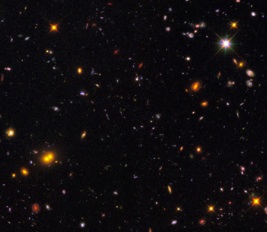AIM hosts a wide range of research themes developed within thematic teams. All teams are strongly involved in national and international collaborations.
The "Cosmology and Galaxy Evolution" team at AIM focuses on studying the formation, evolution, and physical properties of large cosmological structures, galaxy clusters, galaxies themselves, and their internal structures, down to the scales of star formation processes. These structures are studied over cosmic time, from the birth of the first galaxies to the closest present-day objects. This research relies on multi-wavelength observations conducted with state-of-the-art observatories (ALMA, JWST, VLT, IRAM, and Euclid), complemented by cosmological and galaxy evolution simulations using the largest supercomputers in Europe. A constant interplay between observations and simulations is sought to optimize data interpretation and provide the best constraints for structure formation models.
The "Star Formation and Interstellar Medium" team studies in detail the dynamics of the interstellar medium (ISM) in the Milky Way and nearby galaxies of different masses and chemical compositions. The way different observations probe the structure of the ISM (mass, chemical content, turbulence) is increasingly well understood. Radiation transfer in the ISM and light-matter interaction are studied through increasingly refined models and can now be applied to the first small galaxies from the epoch of reionization.
The "Dynamics of Stars, Exoplanets, and their Environment" team conducts cutting-edge research to understand the internal and external structure, dynamics, and evolution of the Sun, stars, planets, and exoplanet atmospheres. In addition, the team studies the multi-scale gravitational, magnetic, and radiative interactions between these celestial bodies and their environment, their winds, and (exo-) space weather, as well as the orbital architecture of planetary systems. This research is based on innovative theoretical predictions, HPC (high-performance computing) numerical simulations, data analysis of observations that constrain models, and instrument development for dedicated space missions (SOHO, Solar Orbiter, JWST, PLATO, Ariel). The work is structured around three interconnected pillars: understanding the Sun and heliosphere, where Solar Orbiter plays a central role, the dynamics and evolution of stars, and that of their exoplanets.
The "High-Energy Cosmic Events" team focuses on the discovery, characterization, classification, and understanding—from the standpoint of fundamental physics—of the most energetic and violent astrophysical phenomena. These sources are usually revealed by their emissions in the high-energy domain (X-rays and gamma rays). The main topics addressed concern the phenomenology of sources and families making up this "Violent Universe," the mechanisms at work in various types of transient sources, the physics and element abundances in supernova remnants (SNR), as well as the physics of shocks and the acceleration of particles and cosmic rays.
The "Cosmology and Statistics" team brings together cosmologists and experts in applied mathematics to develop new statistical and signal processing methods and apply them to data analysis in cosmology or other fields. The activities of the LCS team at AIM mainly focus on two areas: weak lensing and artificial intelligence. Weak lensing: Imaging surveys measure the distortions of galaxy images whose light has been deflected on very large scales by intervening matter. This gravitational lensing effect enables us to determine the fraction of dark matter and dark energy up to about 9 billion years ago. Weak lensing measurements can also be used to test the laws of gravity on large scales. Statistical Methods and Artificial Intelligence: We are working in various directions to optimize information extraction from our large datasets. Key areas include inverse problems, point spread function recovery, and simulation-based inference.
The "Astrophysical Plasma Modeling" team brings together theorists and modelers aiming to understand astrophysical processes governed by gravity, radiative hydrodynamics, and magnetohydrodynamics (MHD), and to characterize their observable consequences. Their theoretical approach is based on physics, utilizing numerical, analytical, and experimental tools suited to the complexity of turbulence, shock waves, and instabilities. The astrophysical questions addressed primarily focus on star formation and protoplanetary disk formation, the birth of compact objects, and the explosive death of massive stars, with inquiries such as: What is the initial mass function of stars? How do protoplanetary disks form? What is the impact of the environment on the properties and evolution of disks? How do massive stars explode? What is their multi-messenger signature? What is the origin of the extreme magnetic fields of magnetars?




